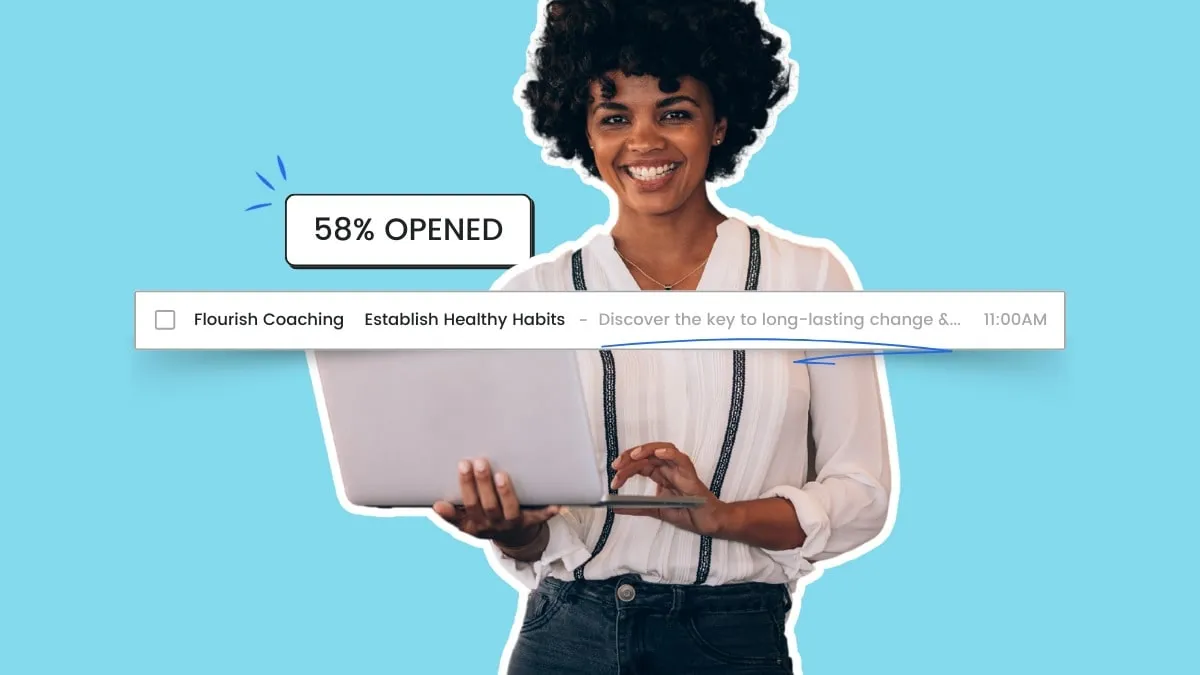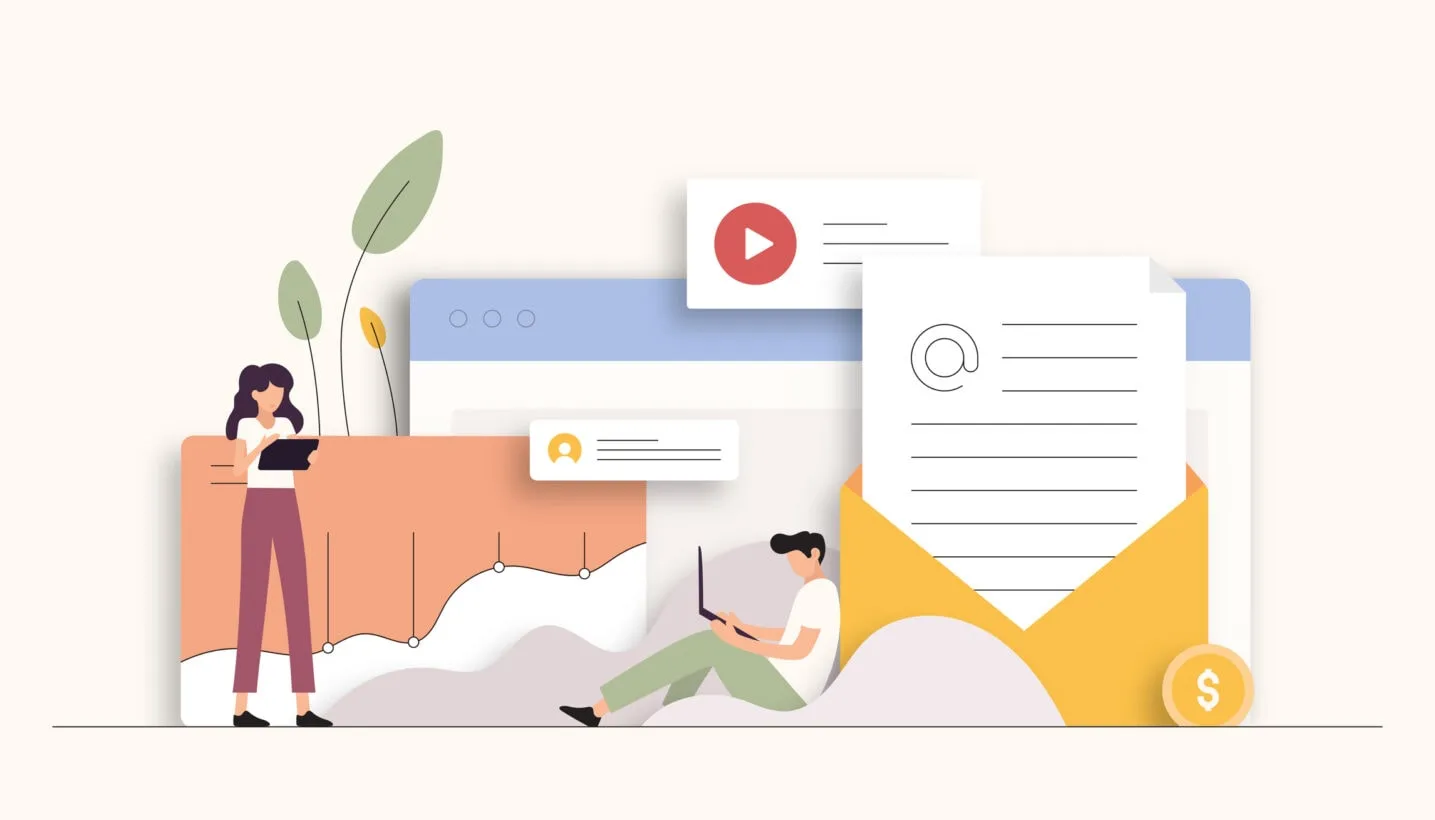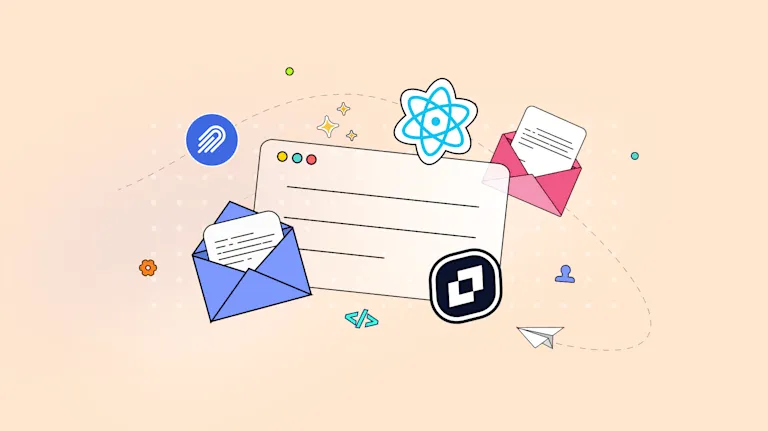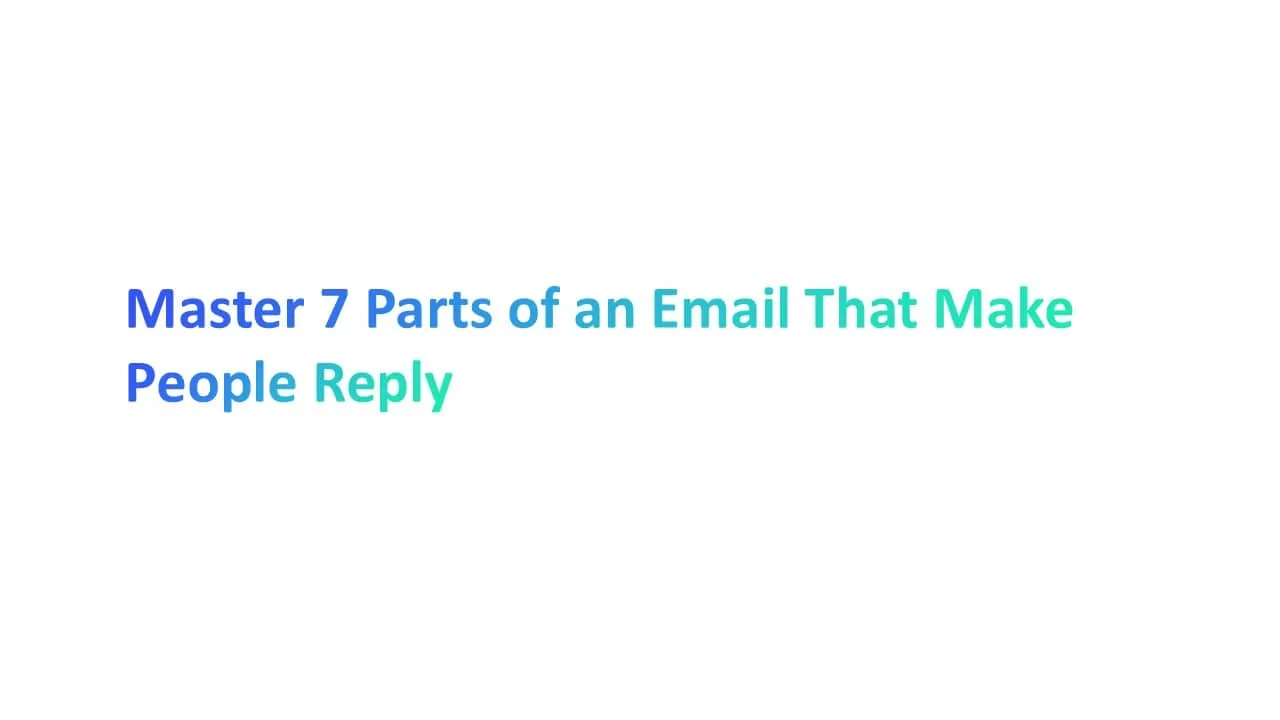Over 333 billion emails are sent daily (Statista, 2023), but most get ignored. Why? Poor structure. If your emails feel like a wall of text or a generic template, people won’t read them—let alone respond.
This guide walks you through the 7 parts of an email, including the crucial email subject line, that actually get replies.
Whether you’re in sales, marketing, or just trying to get a client to answer, you’ll learn what works (and what doesn’t). It’s not rocket science—it’s smart structure. Every element is designed to capture and maintain the recipient's attention.
Ready to fix your emails and boost replies? Let’s break it down—no fluff, just what matters.
Why Structure Matters in Email Communication
If your email doesn’t get replies, it’s not always about what you say—it’s how you say it.
Many people forget to follow the 7 parts of an email that make a real difference. Without structure, your message can feel confusing, unprofessional, or even end up in the spam folder.
Including the recipient's email address correctly is crucial as it identifies who is receiving the message alongside the sender's details and the subject line.
Here’s why it matters:
- Structured emails are easier to read, especially on mobile devices.
- Readers respond more when you use personal touch and relevant message content.
- Bad layout or missing email footer can trigger spam filters.
- A clear format helps email clients like Gmail or Outlook display your email right.
📊 According to HubSpot, emails with a clear structure and personalized subject lines can improve open rates by 50%.
Take the time to follow the right structure. It’s not just about looking professional—it’s about making sure people reply.
Understanding Impact of Emails in Modern Communication
Emails have transformed global communication, becoming vital for marketing, networking, and relationship building. Understanding the 7 parts of an email—such as the subject line, sender’s email address, and email body—is key to success.
Other essentials include the sender’s contact info, job title, company logo, professional email signature, and an email footer with an unsubscribe link and legal disclaimers. These parts ensure your email looks professional, builds trust, and encourages replies.
From your subject line to your call to action, each of the 7 parts of an email represents key elements that improve open and response rates.
Understand the Essential Parts of an Effective Email
1. The Sender’s Details: First Impressions Start Here

The sender’s email address, sender’s contact information, and even your job title and company name form your identity. It’s like your name tag at a meeting.
Why it’s important:
Readers check who sent the email before opening it. If your email address looks spammy, or generic (like noreply@...), people won't trust it.
A real name + company builds trust.
How to get it right:
- Use a professional email address with your company’s identity (like john@yourcompany.com).
- Include your full name, job title, and company logo in your email signature.
- Avoid shady or unclear sender details. Spam filters watch this closely.
💡 Pro Tip: Add your social media links in the signature to give extra credibility.
2. Pre-Header Text: The Hidden Trigger That Boosts Opens

The pre header is the short preview text you see after the subject line in your inbox. Think of it as a second subject line.
Why it’s important:
It’s one of the first things the recipient sees, especially on mobile devices. A good pre header can improve open rates by up to 30% (Campaign Monitor, 2023). It can also trigger spam filters if poorly written or stuffed with sales terms.
How to write a great one:
- Keep it under 100 characters.
- Make it match or support the subject line.
- Use relevant and valuable content that speaks to your reader.
Here’s an example:
- Subject line: “Ready to Save Time on Email?”
- Pre-header: “Learn 3 tips to simplify your outreach today.”
3. Subject Line: Hook the Reader in One Line

The subject line is the first thing your reader sees in their inbox. Think of it as the title of your email message. It’s short but powerful.
Why it’s important:
If your subject line doesn’t grab attention, your email won't even get opened. According to Mailchimp, emails with clear and attention grabbing subject lines get 47% more opens. A weak subject line can send your message straight to the spam folder.
How to write a great subject line:
- Use clear subject lines that match your message.
- Avoid clickbait. Be honest and direct.
- Add a compelling subject line by including numbers or urgency.
- Personalize it using the recipient’s name when possible.
- Keep it short — under 50 characters works best on mobile devices.
- Test different versions in your email marketing or email campaigns.
Examples:
- ❌ “Check this out!” – Too vague.
- ✅ “3 Easy Ways to Improve Your Email Today” – Clear and useful.
4. Greeting & Personal Touch: Set the Tone Right Away

Your greeting is how you start your email. This includes a friendly yet professional greeting, usually with the recipient’s name and maybe a warm phrase like “Hope you’re doing well.”
Why it’s important:
People are more likely to read an email that feels personal. A generic “Hi there” or no greeting at all can make it feel cold or robotic. Adding a personal touch builds trust and shows respect.
In formal or professional emails, using appropriate closings like 'Sincerely' or 'Thank you' can enhance the tone and purpose, leaving a polite and positive impression.
How to write a great greeting:
- Use the recipient’s email address or name directly when possible.
- Choose a professional greeting if it’s a business email (like “Hello [Name],”).
- In more casual or promotional emails, you can be a bit warmer, like “Hey [Name], we’ve got something for you!”
Examples of greetings:
- ✅ “Hi Sarah, hope your week is going well!”
- ✅ “Hello Mr. James – I wanted to follow up on our last chat.”
- ❌ “To whom it may concern” – Too impersonal.
5. Email Body: Delivering Relevant and Valuable Content

The email body is where you write your main message. It comes after the greeting and before the closing line or email signature. This is your space to explain your offer, provide updates, or share something helpful.
Why it’s important:
If the body is unclear, too long, or boring, your reader will stop reading. Your goal is to share relevant and valuable content in a way that’s easy to read. This builds trust and helps people remember your brand.
How to write it effectively:
- Start with a short sentence that explains what the email is about.
- Break content into short paragraphs or bullet points.
- Use simple words and avoid jargon.
- Support your points with data or message content that helps the reader.
Use Embedded Media to Enhance the Message
- Use embedded media like images, charts, or a short video to explain something visually. It helps readers understand better.
- Emails that include interactive elements like GIFs or sliders get more attention, especially in email marketing campaigns. Just make sure they work across all email clients like Gmail, Outlook, or Apple Mail.
Example: Let’s say you’re sending a product update. Add a quick image of the new feature, followed by bullet points that explain what’s changed. Then, link to your website with an embedded link.
6. Call to Action: Get the Desired Action Without Being Pushy

The call to action (CTA) is a short sentence or button that tells your reader what to do next. Examples include “Read More,” “Sign Up,” or “Reply Now.”
Why it’s important:
Without a strong call, your reader may not do anything. You want them to take a step — whether it’s visiting your website, replying to your email, or making a purchase. A weak CTA means your email goes to waste.
How to write a powerful CTA:
- Make it clear. Use action oriented language like “Try,” “Download,” or “Join.”
- Keep it short — no more than 6–8 words.
- Tell them what they’ll get. Example: “Get your free guide.”
- Place it at the end of your email body so it flows naturally.
- Make sure the CTA button or link stands out (bold, colored, or in a separate line).
- Avoid sounding like a sales robot. Keep the tone helpful, not pushy.
Do this:
- Use one CTA per email to avoid confusion.
- Test different CTAs in your email campaigns to see what works best.
- Try using a professional closing like “Let me know if you have questions,” before your CTA — it feels more natural.
🧠 Emails with a CTA have a 371% higher click rate than those without (WordStream, 2023). So don’t skip it — even if it’s as simple as “Reply and let me know what you think.” A thoughtful CTA can encourage recipients to reply faster and take the next step.
7. Email Signature & Footer: Finish Like a Pro

An email signature is the final part of your message. It includes your name, job title, and sender's contact information. The email footer comes below that and may include things like a legal disclaimer, unsubscribe link, or social media links.
Why it’s important:
Your signature tells the reader who you are. A clear and professional email footer builds trust. If it’s missing, your message can look incomplete—or even suspicious. Adding these final touches also helps your message feel more human and credible.
How to do it right:
- Use your full name and job title.
- Add your sender’s email address and phone number.
- Include your company’s name and website.
- Always add a short legal disclaimer if needed.
- Make space for an unsubscribe link in newsletters or email marketing.
- Add social media links to connect further.
📌 Example:
Taylor Smith
Marketing Lead, BrightTech
taylor@brighttech.com | (123) 456-7890
Add Your Company Logo for Credibility and Branding
Your company logo is the image that shows your brand. When placed in the email signature or footer, it shows professionalism.
- Add your logo in the footer or near your signature.
- Make sure it’s small and not pixelated.
- Keep it mobile-friendly so it loads well on all email clients and devices.
- If using an embedded link, make it lead to your homepage or company profile.
Quick Tip: Use your logo and email server name together to confirm your identity. It helps avoid the spam folder and makes you look more professional.
The Role of Email Communication in Building Trust and Action

Email communication is one of the easiest and most common ways people stay in touch at work and in business. Using appropriate closings in professional emails is crucial to maintaining a polite and formal tone. But not all emails get read—or trusted.
If your message is missing any of the 7 parts of an email, people may delete it or ignore it. When done right, email builds trust and helps the reader take the next step—whether that’s replying, clicking, or buying.
- For example, a clear subject line and friendly yet professional greeting make a strong initial impression.
- Your email body should include relevant and valuable content, like important details or easy-to-follow instructions.
- Remember to add a clear call to action that encourages an immediate action, such as clicking a link or replying.
- Including your sender’s information and a neat email signature also helps build trust. People want to know you’re a real person, not a spammer!
Emails that follow this format are easy to understand and more likely to get replies.
📊 Data from Campaign Monitor shows that emails with proper structure have 2x higher engagement.
Also, don’t forget the details. Include a file type or link to an email template if needed. Mention your company name, and keep your tone friendly. A single, well-done email can build a long-term relationship.
- Great email structure = more trust = more action.
Real Email Example With Annotations
Example 1: Sales Outreach Email
Subject Line: Struggling to Keep Sales Reps Focused?
Pre-header: A 3-step guide to boost rep productivity without burning out.
Annotations:
- Subject Line – Asks a direct pain-point-based question
- Pre-header – Teases value (guide + outcome)
- CTA – Conversational, non-pushy
- Footer – Contains social links and company logo
- Email Address – The components of an email address called the username, the at symbol, and the domain ensure the correct structure and functionality of email communication
Example 2: Post-Webinar Follow-Up Email
Subject Line: Your Webinar Replay + Bonus Slides Inside
Pre-header: Thanks for attending! Here’s what we promised.
Annotations:
- Body – Skimmable format with emojis for clarity
- CTA – Actionable and highly visible
- Personalization – Mentions webinar attendance
- Soft reply nudge – Encourages engagement without pressure
Example 3: Content Promotion Email (Newsletter Style)
Subject Line: 🧠 5 Email Subject Lines That Got 52%+ Open Rate
Pre-header: Steal these templates + see the psychology behind them.
Annotations:
- Subject + Pre-header – Use numbers, emoji, and curiosity
- Newsletter style – Consistent, value-packed, skimmable
- CTA – Leads to content (not product)
- Unsubscribe link – Maintains trust and compliance
Best Practices for Email Marketing Campaign

1. Start with a Clean, Segmented List
A clean list means your emails go to real people who want to hear from you. A segmented list means you group your contacts based on things like age, location, or interest.
Sending emails to a bad list can hurt your business. Your message could land in the spam folder or be flagged by email providers.
How to do it right:
- Remove emails that bounce or never open.
- Group your audience by what they care about.
- Use tools that let you create segments easily.
- Respect privacy and include an unsubscribe link.
2. Design for Mobile Devices
Your email should look great on a phone. Today, over 60% of business emails are opened on mobile devices. If your email doesn’t load well, readers will delete it fast.
How to do it right:
- Use short subject lines (under 40 characters).
- Keep your email body simple and scannable.
- Make buttons like the call to action big enough to tap.
- Use one clear main message per email.
- Add visual elements that load fast and look visually appealing.
3. A/B Test Email Campaigns — Subject Lines, CTAs, Send Times
A/B testing means you send two versions of your email to see which one works better. It helps you learn what your readers like—so your next email marketing campaign gets better.
How to do it right:
- Test different subject lines using tools that support crafting subject lines.
- Try two types of call to action (example: “Buy Now” vs. “See Options”).
- Test sending times—morning, afternoon, or weekends.
4. Respect the Unsubscribe Button (And Learn From It)
An unsubscribe link lets people stop receiving your emails if they want to. Every email marketing campaign must include this. It’s not just about following rules. It’s about showing respect.
If people can’t find your unsubscribe option, they might report your email as spam. That can hurt your sender score with email providers and land your future emails in the spam folder.
How to do it right:
- Place the unsubscribe link clearly in your email footer.
- Don’t hide it with small text.
- Use simple wording like “Click here to unsubscribe.”
- Analyze who unsubscribed and when. It tells you what your message recipients didn’t like.
Tip: Use the data to improve your attention grabbing subject line and overall message content.
5. Add Social Media Links for Extended Engagement
Social media links in your emails help people follow you on platforms like Instagram, LinkedIn, or X. It extends the life of your message beyond the inbox. People may not click on your call to action right away. But they may follow you and engage later.
How to do it right:
- Place social icons in your email footer or near your email signature.
- Link only to active profiles.
- Make sure they open in a new tab.
- Use tools to track which social links get clicked.
Campaign Monitor says emails with social media links see a 158% higher click-through rate.
6. Don’t Let Email Providers Block Your Success
Email providers like Gmail, Outlook, or Yahoo use filters to protect users. If you don’t follow best practices, your email might never reach the inbox.
No one can reply to an email they never see. Even if you wrote the perfect email body and subject line, it’s useless if blocked.
How to stay out of trouble:
- Include clear sender’s information, like name and business.
- Avoid spammy words like “Free!” or “Act Now!”
- Don’t attach large files. Use embedded links instead.
- Make sure your HTML code is clean.
- Send emails only to people who opted in.
Bonus: Use email server tools to check deliverability before sending.
Tips to Optimize Marketing Emails for Replies and Reach

1. Use “You” More Than “We”
Speak directly to your reader. Focus less on your brand and more on them. People care about how your message helps them. Saying "You’ll love this" is stronger than "We created this."
How to apply it:
- Change “We are launching a product” to “You’ll get early access.”
- Use second-person words (“you,” “your,” “you’ll”) throughout the email body.
- It feels personal—even if it’s part of a bigger email marketing campaign.
This simple shift is one of the most essential components of emails that get replies.
2. Make Your CTA Sound Like a Question
Your call to action (CTA) should invite the reader to think and respond. Questions feel more natural. They create curiosity and invite a click.
How to write it:
- Instead of “Download Now,” say “Want to try this today?”
- Instead of “Join,” try “Ready to take the next step?”
- Keep it short—a strong call is 6–8 words.
End your closing line with a simple question like “Does that sound good to you?”
3. Time It Right — Tuesday at 10 AM or Thursday at 1 PM
Send your emails when people are most likely to check their inbox. Timing is a huge part of getting seen. Even the best crafted subject lines won’t help if the email gets buried.
What studies show:
- Tuesday at 10 AM is great for professional readers.
- Thursday at 1 PM works well for business emails.
- Avoid weekends and late evenings.
If you don’t get a reply, follow up after 2–3 days using the same thread. That keeps your message effectively connected.
4. Keep It Under 125 Words
Short emails win. People are busy, and long texts lose recipient’s attention fast. A short email is easy to read, quick to act on, and shows respect for your reader’s time.
How to do it:
- Aim for 2–3 short paragraphs.
- Get to the main message quickly.
- Cut out extra fluff or repeated info.
- Stick to essential elements only.
If it’s too long, your essential parts might get ignored.
5. Follow Up 2–3 Times (But Vary the Angle)
Don’t give up after one email. Most replies come after a second or third follow-up. People miss emails or need reminders. A second email gives them another chance to respond.
How to follow up smartly:
- Wait 2–3 days between each message.
- Use a different subject line or hook each time.
- Include your original message using carbon copy (cc) if needed. If you're looping in someone silently, use the blind carbon copy (BCC) feature to avoid clutter and maintain privacy.
- Add additional context or value in each follow-up.
Example: First email: “Still interested?” Follow-up: “3 Ways This Helps You Today.”
6. Don’t Land in the Spam Folder
Avoid words, formats, or links that set off spam filters used by email providers. If your email goes to spam, the reader never sees it—no reply, no action.
How to avoid spam traps:
- Don’t use too many exclamation marks.
- Add your sender’s email address and a real top level domain (like .com).
- Always include a clear unsubscribe link.
- Test your email using tools that scan for spam issues.
Reminder: Always use a valid email template and avoid shady links.
7. Add a P.S. to Reinforce or Personalize Your Message
Use a P.S. at the end of your email. It grabs attention and feels personal. Many people skim emails. They often read the P.S. first or last.
How to write a great P.S.:
- Include a benefit or deadline.
- Use personalized greetings like “P.S. Mike, this would save you hours.”
- Add a soft call to action like “Need more info? Just reply.”
- Finish with a human professional closing like “Thanks again” or “Best regards”.
Example: P.S. Want to test this out today? I can help.
FAQS
- What's CC and BCC in email?
CC stands for "carbon copy" and BCC means "blind carbon copy." Both let you send the same email to multiple people, but BCC hides the recipients from each other. - What are the 7 parts of an email everyone should include?
The 7 parts are: sender’s email address, subject line, pre-header text, greeting, email body, call to action, and signature/footer. Each part helps guide the reader and builds trust. - Do I need to include all 7 parts in every email?
Yes, especially in formal or professional emails. Skipping key parts like the subject line or closing can confuse readers or make your message seem incomplete.
Mastering the 7 parts of an email isn’t about being perfect—it’s about being clear, human, and helpful. Every part, from the subject line to the closing, plays a role in getting replies. Stick to the structure, keep it simple, and make it easy for your reader to take action. Small changes lead to real results.





.jpg)

.jpg)
